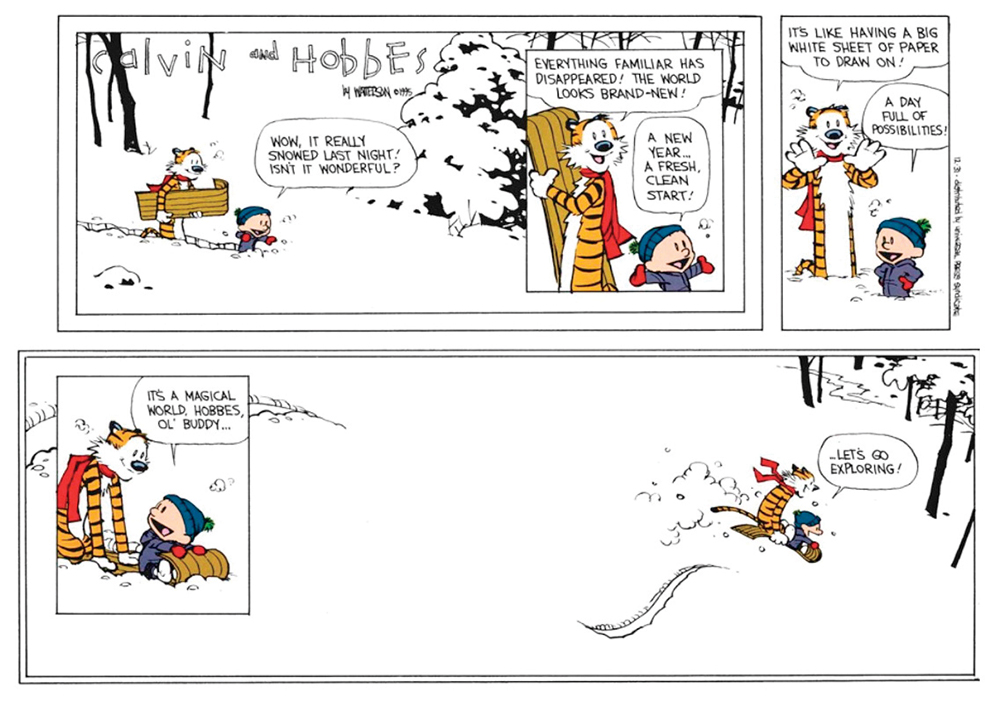
You likely don’t recognize the name “Bill Watterson.” But you very likely recognize the names of his creations: mischievous five-year-old Calvin and his stuffed tiger, Hobbes. From 1985 to 1995, Bill brought newspaper readers along for the (often zany) ride as Calvin navigated school, home, friends and hungry tigers. Scattered throughout are philosophical musings on the meaning of life, the existence of God, politics and much more.
At the end of the 10th year, Bill made the difficult decision to end the strip. But how does one end such a wide-ranging story? Readers had become part of Calvin’s life for 10 years; what would be the best way to create closure? The iconic last strip of Calvin and Hobbes, printed Dec. 31, 1995, comprises three panels. In the first, Calvin and Hobbes are walking with their trusty sled through a winter wonderland, trudging through knee-deep snow. “Everything familiar has disappeared! The world looks brand-new!” Hobbes exclaims. “A new year … a fresh, clean start!” exults Calvin. “It’s like having a big white sheet of paper to draw on!” “A day full of possibilities!” And finally, the last panel, stretching the length of the page: it is almost entirely white—a nod to the “big white sheet of paper” just mentioned—with just a few trees in the corner and a sled mark or two to mar the fresh, untouched snow. As Calvin and Hobbes mount their sled, ready to ride off over the hills for the last time, Calvin comments: “It’s a magical world, Hobbes, ‘ol buddy … let’s go exploring!”
The dialogue and imagery combine to give this ending the punch that it has. The openness of the last panel—portraying the untrammeled snow stretching out ahead of the sled—reinforces Calvin’s final line: “It’s a magical world; let’s go exploring.” Essentially, what Bill did was not end the strip, but show how really, the story had just begun. He was releasing Calvin and Hobbes to sled away from the panels, the daily strips and go wherever life took them; the world was their oyster.
L’havdil, the same feeling is evoked by the end of the Torah. Bnei Yisrael are gathered mere feet from the promised land; the end of the book is not the end of the story, but the last step before the story really begins in earnest. A possible utopia—a return to Eden—lies before them, if they can just embody the ideals they learned and practiced over the previous 40 years. The challenge is immense, but the potential is just as great.
This book, too, is not meant to end, but to indicate the beginning. With the values and ideals developed here, you—as an individual—can step into an entirely new perspective on life. As a soldier in the Great Battalion, everything is open before you; the world presents limitless opportunities to identify your strengths, diagnose where those strengths are needed and wade into the fray to take on the challenge. All it takes is the commitment to try.
Rows and rows of soldiers fill the field. Each one faces forward, standing tall and proud. Each one holds his tools of the trade: one row of doctors and nurses in lab coats, stethoscopes hanging around their necks. Another of computer programmers holding gleaming laptops, headphones perched over their ears. Photographers, engineers, electricians, carpenters, architects, musicians, artists, first responders and lawyers are arrayed behind them. Pride of place is given to the ranks of teachers, rabbanim and other members of direct klei kodesh. Everyone recognizes that they are serving their Commander exactly as He wants of them. They’ve chosen to be part of the tzevaos Hashem; together, they’ve dedicated themselves to improving themselves, their communities and the world at large. With such a mindset, with everyone dedicated to the mission, they are confident; they will succeed.
“Behold the Great Battalion / That stands side by side,
Too few in number / But too proud to hide,
And say to the others / Who did not follow through,
You’re still our brothers / And we will fight for you.”
Tzvi Goldstein graduated from Yeshiva University with semicha and a degree in Psychology. After making aliyah, he taught in Yeshivat Hakotel for five years and now edits sefarim for a number of publishers. He recently published a sefer with Mosaica Press called, “Halachic Worldviews,” exploring Rav Soloveitchik’s approach to developing hashkafa from halacha, and writes at tgb613.substack.com. You can reach him at [email protected].








